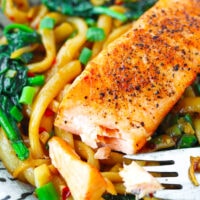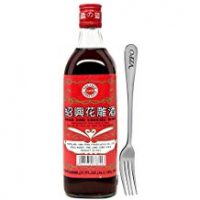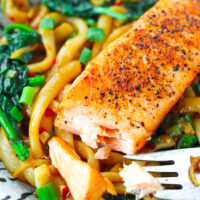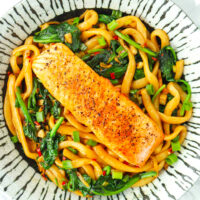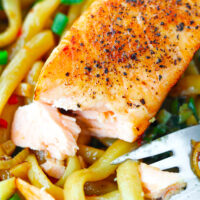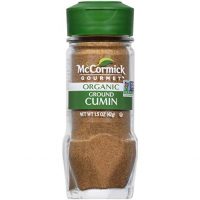 Buy Now →
Buy Now → Spicy Cumin Noodles with Salmon
Chewy udon noodles get tossed with fragrant aromatics, ground cumin, Sichuan peppercorns, and Asian greens in a delicious savory-sweet and spicy sauce! Crowned with a perfectly pan-fried salmon fillet, these Spicy Cumin Noodles is weeknight comfort food at its best!
- Prep Time: 15
- Cook Time: 15
- Total Time: 30 minutes
- Yield: 1 1x
- Category: Dinner
- Method: Stir-fry
- Cuisine: Sichuan-inspired
Ingredients
Scale
For the Spicy Cumin Noodles:
- 7 ounces / 200 grams Udon Noodles (I used a vacuum sealed pack – note 1)
- 2 Garlic Cloves – roughly chopped
- 1 Spring Onion (Scallion/Green Onion) – finely chopped, white and light green parts separated from dark green parts
- 1 – 3 fresh Red Chilies (Thai Bird’s Eye or any other small hot red chilies), to taste – finely chopped
- ½-inch piece Ginger – pieced and julienned (about 1 tablespoon of julienned ginger)
- 1 cup sliced Asian Greens (Chinese baby spinach or regular Chinese spinach, bok choy, choy sum, Chinese broccoli – ‘gai lan’) – fibrous stems removed if using spinach
- ¼ TSP Sichuan Red Peppercorns (note 2) – twigs and black seeds removed (or substitute with ground Sichuan peppercorns)
- 2 TBLS Canola Oil (or other neutral cooking oil)
For the Sauce:
- 1 TBLS Low Sodium Light Soy Sauce
- ½ TBLS Shao Xing Rice Wine (or substitute with dry sherry)
- 1 TBLS Oyster Sauce
- 1 TSP Sesame Oil
- ½ TSP White Sugar
- ¼ TSP Crushed Red Pepper Flakes, to taste
- ¼ TSP Ground Cumin
For the Salmon:
- 1 (about 120 grams/4–5 ounce) Salmon Fillet, boneless, skin-on (note 3)
- ⅛ – ¼ TSP Kosher Salt, to taste
- ⅛ TSP freshly cracked Black Pepper, to taste
- ½ TBLS Canola Oil
Instructions
Prep:
- Prepare the fresh and dry ingredients: Chop/slice the garlic, spring onion, fresh red chilies, ginger, and Asian greens as indicated in the ‘Ingredients’ section. Toast the Sichuan red peppercorns for a minute in a skillet until aromatic. Use a mortar and pestle to grind into a coarse powder and set aside. (Note: If using whole cumin seeds, toast with the Sichuan peppercorns and grind too. Add both into the wok in step 4.)
- Make the sauce: Whisk together the low sodium light soy sauce, Shao Xing rice wine, oyster sauce, white sugar, ground cumin, crushed red pepper flakes and sesame oil in a measuring cup or small bowl until thoroughly combined.
- Prepare the salmon: Remove the salmon fillet from the packaging it came in and gently pat-dry with paper towels. Place on a plate and season with kosher salt and freshly cracked black pepper to taste.
For the Spicy Cumin Noodles with Salmon:
- Pan-fry the salmon: Heat ½ tablespoon canola oil in a medium skillet over medium-high heat. Once hot, place the seasoned salmon fillet skin side down in the skillet and allow to sear for 1 minute. Turn the fillet over and cook for 1-2 minutes. Use tongs to turn the fillet onto its side and cook each side for 15-20 seconds or until crisp and browned too. Once cooked to your liking, switch off the heat and transfer to a clean plate to rest.
- Prepare the noodles: Bring a small pot of water to a boil and place the noodle cake in it. Use tongs to grab onto the cake and gently shake to loosen the strands. Once loosened and tender, drain into a colander and run cold water on top to prevent sticking. (Note: If using dried or frozen noodles, cook according to package instructions.)
- Stir-fry the aromatics: Heat 2 tablespoons canola oil in a large wok (or heavy bottomed deep edged frying pan) over high heat. Once hot, lower the heat to medium-high and add the spring onion white and light green parts and ginger. Stir-fry for 20 seconds until you can smell the ginger, then add the garlic and red chilies and stir-fry for another 20 seconds until fragrant.
- Add the Asian greens: Add the Asian greens and stir-fry for 30 seconds or until just starting to wilt and soften.
- Add the noodles, sauce and Sichuan red peppercorns: Add the noodles and pour the sauce over them. Sprinkle the ground Sichuan peppercorn on top. Stir-fry for 1 minute, until the noodles are evenly coated with the sauce and the Asian greens are crisp tender.
- Toss through spring onion: Toss through most of the spring onion dark green parts (reserve a few pieces for garnish) and switch off the heat.
- To Serve: Transfer to a plate or bowl. Peel off and discard the skin of the salmon fillet if desired and place on top of the noodles. Garnish with the reserved spring onion dark green parts and serve immediately.
Notes
- Udon Noodles. I used vacuum sealed packs of pre-cooked udon noodles. They can be found online and at Asian or Japanese supermarkets. You can use frozen udon noodles too or par-cooked udon noodles from the fridge section. Feel free to swap for a vacuum sealed pack of Shanghai noodles, ramen, knife cut or any other type of noodles you like. You can use fresh flat wide rice noodles (like the ones used in chow fun or pad see ew) if you prefer too. Dried udon can be used in a pinch, but note that it won’t have the same bouncy and chewy texture.
- Sichuan Red Peppercorns: These have a numbing hot flavor and make your tongue buzz a little. Find them at an Asian or Chinese supermarket or online. Alternatively, you can use ground Sichuan peppercorn to save time. It can be found in most large supermarkets that are well-stocked with international ingredients.
- Salmon. Cod, pollock, halibut, mahi-mahi, tuna, tilapia, sea bass or other firm fish can also be used instead of salmon. You can also use sautéed shrimp. Season with salt and pepper and cook separately in a pan first. Add to the wok when you add the noodles and sauce and toss through.
- Adjust the spice level to taste. Use more or less fresh red chilies and crushed red pepper flakes based on your heat level preference. Feel free to also adjust the amount of Sichuan red peppercorns and ground cumin to taste.
- Make it gluten-free. Use a gluten-free soy sauce, oyster sauce, and dry sherry instead of Shao Xing rice wine. Swap the udon noodles for fresh flat wide rice noodles, thin rice vermicelli (like the one I’ve used for spicy curry laksa), or other gluten-free noodles of your choice.
- Double the recipe. To make 2 servings, simply double all the ingredients. (Click the ‘2x’ button at the top of the recipe card to show double the ingredients amounts). Use a large enough wok or pan for the cumin noodles stir-fry. Or cook in two batches if your wok isn’t very large.
- Recipe inspired by Marion’s Kitchen.
Nutrition
- Serving Size: 1
- Calories: 832
- Sugar: 6.2g
- Sodium: 1385.1mg
- Fat: 46.3g
- Saturated Fat: 4.7g
- Unsaturated Fat: 38.7
- Trans Fat: 0.2g
- Carbohydrates: 69.1g
- Fiber: 2.5g
- Protein: 35.5g
- Cholesterol: 55.2mg
Find it online: https://thatspicychick.com/spicy-cumin-noodles-with-salmon/
